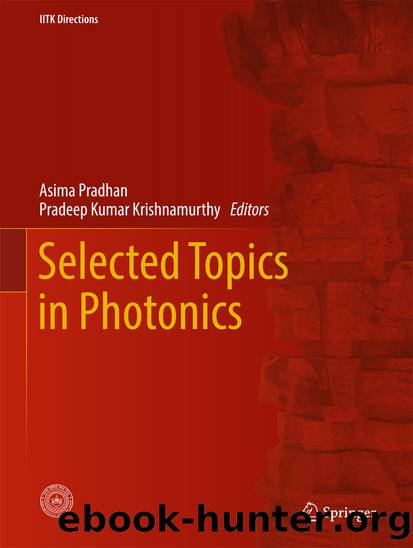Selected Topics in Photonics by Asima Pradhan & Pradeep Kumar Krishnamurthy

Author:Asima Pradhan & Pradeep Kumar Krishnamurthy
Language: eng
Format: epub
Publisher: Springer Singapore, Singapore
7 Laser-Induced Selective Inter-pixel Band Gap Blueshift
To further investigate this phenomena of laser induced layer intermixing to be the reason for this increase in inter-pixel isolation, optical measurements using Fourier Transform Infrared (FTIR) spectroscopy has been carried out on a 400 μm square pixel array . For the Perkin Elmer FTIR spectrometer measurements, the IR source is incident normally from the substrate side of the T2SL and the transmission spectra are detected using a pyroelectric detector. For the FTIR spectra of the active photodiode regions , the inter-pixel T2SL regions have been completely removed after fs-laser anneal using 1H3PO4: 2H2O2: 20H2O and to serve as a datum the complete T2SL have been etched off to reveal the GaSb substrate. [21]
Figure 8 shows the normalized absorbance spectra of as-grown SL, p + only-etched laser annealed T2SL and that of the datum GaSb substrate at room temperature. The first-order derivative of the absorbance clearly identifies the peaks as well as quantifies the shifts in the T2SL band gap. In the p + only-etched fs-laser annealed T2SL, the absorbance peaks correspond to the hh1-e1 and lh1-e1 transition of Fig. 2, as marked with arrows in Fig. 8. The first hh1-e1 transition (0.336 eV) and the second lh1-e1 transition (0.411 eV) are blueshifted by ~74 and ~63 meV, respectively in the laser annealed T2SL from that of the as-grown T2SL is attributed to SL layers intermixing which leads to form an InxGa1-xAsySb1-y/Inx′Ga1-x′Asy′Sb1-y′ alloy T2SL structure. This is the first report of post growth modification of the SL band gap, selectively. To ensure that the peaks shifts identified are due to intermixing and not due to artifacts in the FTIR measurement, a study similar to those done by others [22], has also been conducted. The same T2SL samples with a 200 nm ZrO2 cap were subjected to a Rapid Thermal Lamp Anneal (RTA) carried out at 500 and 550 °C for 30 s in a forming gas atmosphere. A ramp rate of 50 °C/s has been used for the RTA before the 30 s anneal. Post annealing, the ZrO2 cap layer is removed by HF and characterized by FTIR spectroscopy at 300 K. At 500 °C, as shown in Fig. 9, the hh1-e1 and lh1-e1 peaks are blueshifted by ~120 and ~100 meV, respectively from that of the as-grown T2SL . Similar, but larger shifts are observed for 550 °C anneal, confirming T2SL layers intermixing. The observed absorbance values for both the fs-laser annealed and RTA annealed T2SL structures are larger as compared to the as-grown layer due to rearrangement of strain in the intermixed layers.
Fig. 8300 K absorbance spectra and its first-order derivative for as-grown T2SL, p + etched laser annealed SL and GaSb substrate datum
Download
This site does not store any files on its server. We only index and link to content provided by other sites. Please contact the content providers to delete copyright contents if any and email us, we'll remove relevant links or contents immediately.
| Automotive | Engineering |
| Transportation |
Whiskies Galore by Ian Buxton(41718)
Introduction to Aircraft Design (Cambridge Aerospace Series) by John P. Fielding(33016)
Small Unmanned Fixed-wing Aircraft Design by Andrew J. Keane Andras Sobester James P. Scanlan & András Sóbester & James P. Scanlan(32684)
Craft Beer for the Homebrewer by Michael Agnew(18081)
Turbulence by E. J. Noyes(7893)
The Complete Stick Figure Physics Tutorials by Allen Sarah(7264)
Kaplan MCAT General Chemistry Review by Kaplan(6822)
The Thirst by Nesbo Jo(6758)
Bad Blood by John Carreyrou(6476)
Modelling of Convective Heat and Mass Transfer in Rotating Flows by Igor V. Shevchuk(6353)
Learning SQL by Alan Beaulieu(6158)
Weapons of Math Destruction by Cathy O'Neil(6084)
Man-made Catastrophes and Risk Information Concealment by Dmitry Chernov & Didier Sornette(5877)
Digital Minimalism by Cal Newport;(5586)
Life 3.0: Being Human in the Age of Artificial Intelligence by Tegmark Max(5404)
iGen by Jean M. Twenge(5322)
Secrets of Antigravity Propulsion: Tesla, UFOs, and Classified Aerospace Technology by Ph.D. Paul A. Laviolette(5237)
Design of Trajectory Optimization Approach for Space Maneuver Vehicle Skip Entry Problems by Runqi Chai & Al Savvaris & Antonios Tsourdos & Senchun Chai(4957)
Electronic Devices & Circuits by Jacob Millman & Christos C. Halkias(4865)
